When most people hear of a home inspection, they often assume that it’s in reference to a buyer’s inspection prior to purchasing real estate. While that is the more commonly known type of inspection, there are also 4-point home inspections. A 4-point home inspection is specifically requested by home insurance providers. 4-Point home inspections look at the four major systems of a home to asses risk. The four systems are the roof, electrical, plumbing, and HVAC.
The four areas covered during 4-point home inspections are also generally the most expensive to repair. In this comprehensive guide, we will delve into the world of 4-point home inspections, exploring their purpose, the areas they cover, their benefits, and how they differ from buyer/seller inspections. We will also discuss the costs involved, how to prepare for a 4-point inspection, and why these assessments are a worthwhile investment for homeowners.
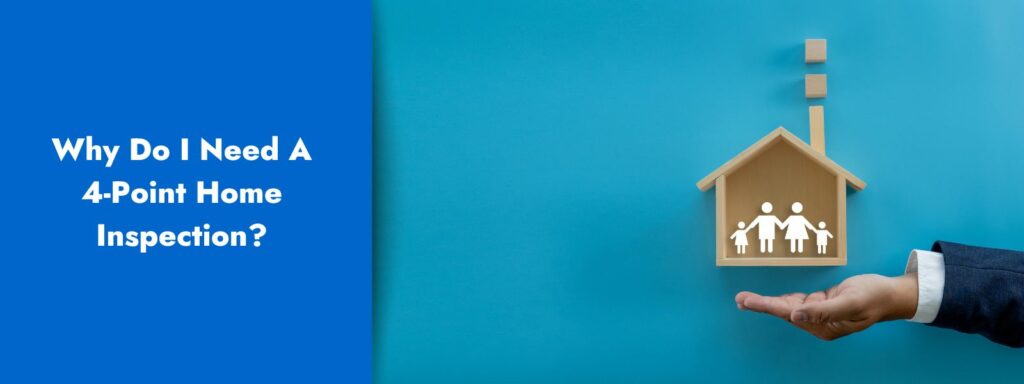
Why Do I Need a 4-Point Home Inspection?
A 4-point home inspection is an essential component of responsible homeownership. Many insurance companies require a 4-point inspection for older homes or homes with certain risk factors. During a 4-point inspection, an inspector will evaluate the four systems in your home that most commonly result in insurance claims, namely:
- Electrical
- Roof
- Plumbing
- HVAC
If your home fails one or any part of the inspection, the inspector will explain what issues need to be addressed. Completing the necessary repairs may be required to obtain insurance coverage. A 4-point inspection is not an alternative or a replacement for a new home inspection. If your insurance company requires you to have an inspection, ask what type of inspection you need. As a homeowner, it might be your responsibility to provide a professional inspection report in order to meet the requirements of insurance coverage.
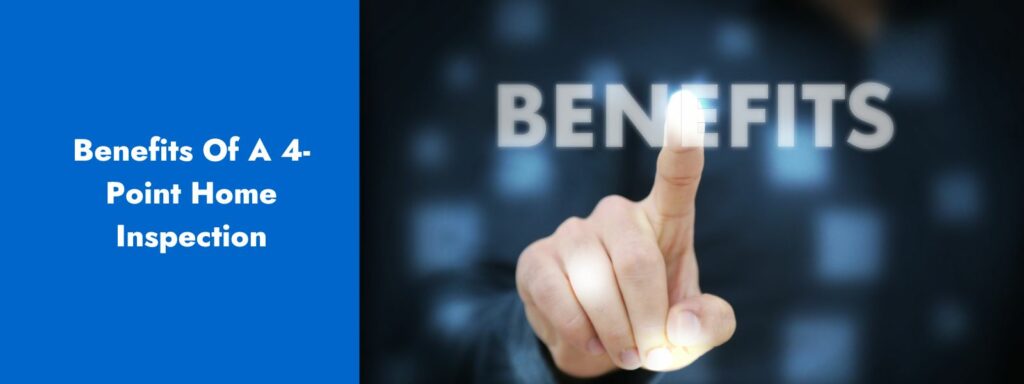
Benefits of a 4-Point Home Inspection
Now that we understand the importance of a 4-point home inspection, let’s delve into the various benefits it offers:
Insurance Savings
When your home is in good condition and meets safety standards, you are more likely to qualify for lower insurance premiums. A 4-point inspection can help you prove your home’s eligibility for such discounts.
Negotiating Power
If you plan to sell your home, having a recent 4-point inspection report can give you an edge in negotiations. You can address issues before listing your home, making it more appealing to potential buyers.
Preventive Maintenance
By catching problems early, a 4-point inspection allows you to perform necessary repairs and maintenance, ultimately saving you money in the long run.
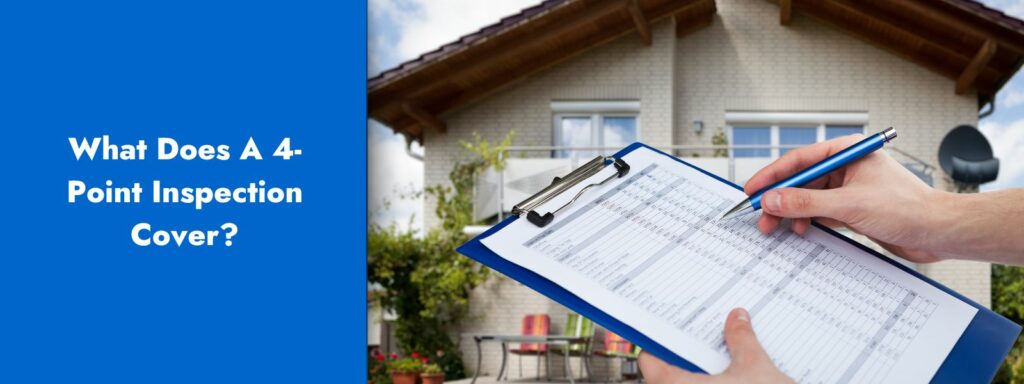
What Does a 4-Point Inspection Cover?
A 4-point home inspection focuses on four primary areas that are crucial to a home’s safety and functionality: the roof, electrical system, plumbing, and HVAC (Heating, Ventilation, and Air Conditioning) system. Let’s explore each of these areas in more detail:
1. Roof
The condition of the roof is a key component of a 4-point inspection and is generally the most comprehensive part of the inspection. Roofs are an essential component of a home or building’s structure, affecting things like energy efficiency and mold accumulation. Inspectors look for potential risks to occupant health and safety that may compromise a home’s structural integrity.
During a 4-point home inspection, inspectors assess roofs for the following factors:
- Roof Materials & Age: Inspectors examine the type of roofing materials in use (e.g., asphalt shingles, metal, tile) and determine their condition. They also assess the age of the roof, as older roofs are more prone to issues. In general, roofs need to be replaced every 20 years or so.
- Visible Damage: The inspector checks for visible signs of damage, such as missing or damaged shingles, cracked tiles, or loose flashing. Any openings or penetrations on the roof, like chimneys or vents, are examined for proper sealing.
- Leaking: Evidence of leaks or water intrusion, such as stains on attic insulation or ceilings, is a concern. Inspectors look for any signs of leaks and evaluate the effectiveness of the roof’s drainage system.
- Structural Issues: Structural aspects of the roof, including the condition of the rafters, trusses, and sheathing, are assessed for integrity and potential weaknesses.
2. Electrical
The electrical system is examined for safety hazards, including outdated wiring, improper installations, and potential fire risks. The inspection also evaluates the functionality of outlets, switches, and the main electrical panel.
During a 4-point home inspection, inspectors assess electrical systems for the following factors:
- Wiring and Connections: Inspectors evaluate the electrical wiring throughout the house to ensure it is up to code and in good condition. They check for any visible damage, loose connections, or exposed wires.
- Electrical Panels: The main electrical panel and subpanels are inspected for proper labeling, circuit breaker functionality, and signs of overheating or electrical hazards.
- Outlets and Switches: The functionality of outlets, switches, and GFCIs (Ground Fault Circuit Interrupters) is verified to ensure they are working correctly and are appropriately placed in areas like bathrooms and kitchens.
- Grounding and Bonding: The inspector assesses the grounding and bonding of the electrical system to ensure it meets safety standards and protects against electrical shocks and fires.
3. Plumbing
Plumbing inspections check for leaks, corroded pipes, drainage issues, and the condition of fixtures such as faucets and toilets. Ensuring proper plumbing is essential to prevent water damage and mold growth.
During a 4-point home inspection, inspectors assess plumbing for the following factors:
- Pipe Materials: Inspectors identify the type of plumbing pipes in use (e.g., copper, PVC, galvanized steel) and check their condition for signs of corrosion, rust, or damage.
- Leaks & Drainage: Water supply lines and drainpipes are inspected for leaks, blockages, and proper drainage. Fixtures like sinks, toilets, and showers are checked for functionality and leaks.
- Water Heater: If applicable, the water heater is examined for its age, condition, and safety features. Inspectors look for signs of corrosion, adequate pressure relief valves, and proper venting.
- Sewer Lines & Septic Tanks: If applicable, the inspector assesses the condition of sewer lines and septic tanks, checking for blockages or signs of malfunction.
4. HVAC
The HVAC system’s inspection assesses the heating and cooling systems’ efficiency, age, and safety. It also checks for proper ventilation and the condition of ductwork.
In addition to these primary areas, inspectors may also look at structural components, insulation, and other critical features depending on your location and specific needs.
During a 4-point home inspection, inspectors assess HVAC systems for the following factors:
- Heating & Cooling Units: The inspector evaluates the condition, age, and efficiency of both the heating and cooling systems. They check for proper ventilation and combustion air supply for gas furnaces.
- Ductwork: The condition of ductwork is assessed for leaks, insulation quality, and proper distribution of conditioned air throughout the home.
- Thermostats & Controls: Thermostats and HVAC controls are inspected to ensure they are functioning correctly and accurately regulating the temperature in different zones of the house.
- Air Filters: The condition of air filters is examined, and recommendations may be made for replacement or maintenance to ensure optimal air quality and system efficiency.

4-Point Inspection vs. Buyer/Seller Inspection
It’s important to distinguish between a 4-point home inspection and a new home inspection (a.k.a. buyer inspection, real estate inspection, home inspection, full inspection depending on location). This distinction is important because the new home inspection is required to close on a home and meet eligibility criteria for your mortgage. While they serve similar purposes, there are key differences between the two:
4-Point Home Inspection
- Focuses on four specific areas: roof, electrical, plumbing, and HVAC.
- Often required for insurance purposes.
- Helps homeowners identify safety hazards and potential issues.
- Typically takes about 30 minutes & is only visual.
- May be required for older homes or homes with specific risk factors.
Buyer/Seller Inspection
- Provides a more comprehensive assessment of the entire property.
- Aids buyers in making informed purchase decisions.
- Assists sellers in identifying and addressing issues before listing.
- Typically takes 2 – 3 hours to complete
- Covers all aspects of the home, including structural components, appliances, and more.
- Not always required by insurers but highly recommended for buyers.
4-point inspections are more common in coastal regions like Florida and Texas. Coastal areas are subjected to hurricanes and tropical storms that can devastate entire communities. To help mitigate the damage wrought by mother nature, lawmakers regularly update building codes. Homes built 30 or 40+ years ago were built to less stringent standards than modern homes, which is why they aren’t considered as safe.
4-point inspection vs. wind mitigation inspection
A wind mitigation inspection identifies and assesses your home’s wind-resistant features. These features can include door and window coverings, roof shapes, roof-deck attachments, and roof coverings. Similar to a 4-point inspection, a wind mitigation inspection is necessary for insurance companies to issue insurance.
Ultimately, the point of this inspection is to inform you and your insurance provider of how resistant your home is to wind damage. This is the only type of inspection that could lead to a reduction in the cost of your insurance policy.
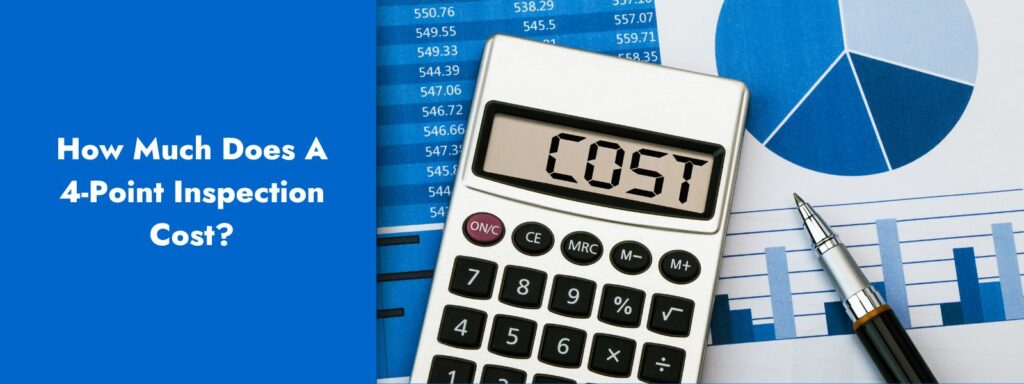
How Much Does a 4-Point Inspection Cost?
The cost of a 4-point home inspection can vary based on several factors, including the location of your property, its size, and the inspection company you choose. On average, you can expect to pay between $50 and $200 for a 4-point inspection. However, it’s crucial to keep in mind that this cost is a small investment compared to the potential savings and peace of mind it can provide.
To get an accurate estimate, contact multiple inspection companies and request quotes. Be wary of choosing solely based on price; consider the company’s reputation, experience, and qualifications as well. Check out their home inspection website to learn more about their approach to 4-point inspections. Ask what type of home inspection software they use to perform inspections. You could also ask to see a sample report
How Do I Prepare for a 4-Point Inspection?
Preparing for a 4-point home inspection can help streamline the process and ensure a more accurate assessment of your property. Here are some steps to take:
Gather Relevant Documents
Compile any documentation related to your home, such as maintenance records, receipts for recent repairs, and the age of major systems (e.g., the roof, HVAC).
Clear Access
Ensure that the inspector has clear access to all areas to be inspected. This includes the attic, crawl spaces, electrical panels, and HVAC systems. Move any obstacles or stored items that may hinder inspection.
Make Necessary Repairs
If you are aware of any issues that need attention, it’s a good idea to address them before the inspection. This can include fixing leaks, repairing faulty electrical outlets, or addressing plumbing problems.
Be Present
While it’s not required, being present during the inspection can be beneficial. It allows you to ask questions, gain insights into your home’s condition, and address any immediate concerns with the inspector.
Prepare to Provide Information
Be ready to answer questions about your home, such as the age of the roof, any recent renovations, and any known issues. This information can help the inspector in their assessment.
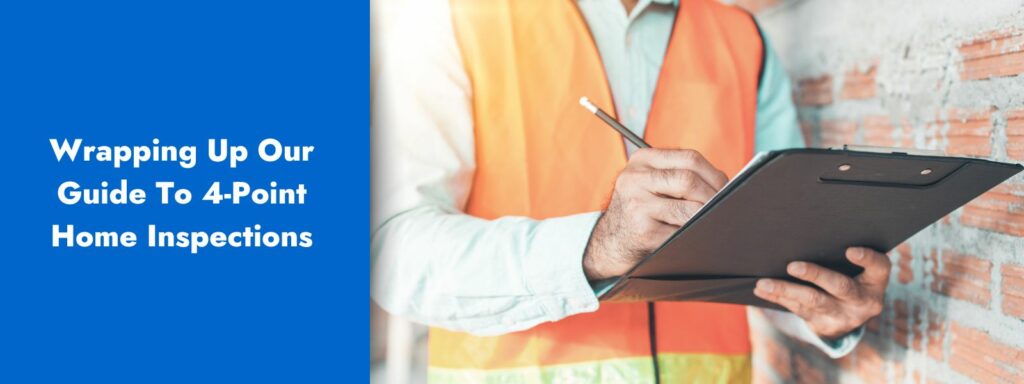
Wrapping Up Our Guide to 4-Point Home Inspections
In conclusion, a 4-point home inspection is a powerful tool that offers homeowners invaluable insights into the condition of a property’s most critical components. By focusing on the roof, electrical system, plumbing, and HVAC system, this inspection provides your insurer with important information about your home’s risk.
The benefits of a 4-point inspection are numerous. It provides peace of mind by identifying hidden issues and helps homeowners save on insurance premiums. Additionally, preventive maintenance stemming from the inspection findings can save you both time and money in the long run.
While the cost of a 4-point inspection may vary, it is a small investment compared to the potential savings and security it can provide. Preparing for the inspection by gathering relevant documents, clearing access to critical areas, and addressing known issues can streamline the process and ensure a more accurate assessment.
In the end, a 4-point home inspection serves as a vital step in responsible homeownership, offering a clear path to maintaining property value, safety, and the overall well-being of your home. As a homeowner seeking to protect your investment, a 4-point inspection is a wise decision that pays dividends in terms of peace of mind and financial security.If you’re a home inspector, you can streamline your 4-point home inspection process with the best home inspection software available, from EZ HIS. Feel free to contact us with any questions or give our software a try with our FREE Trial!

